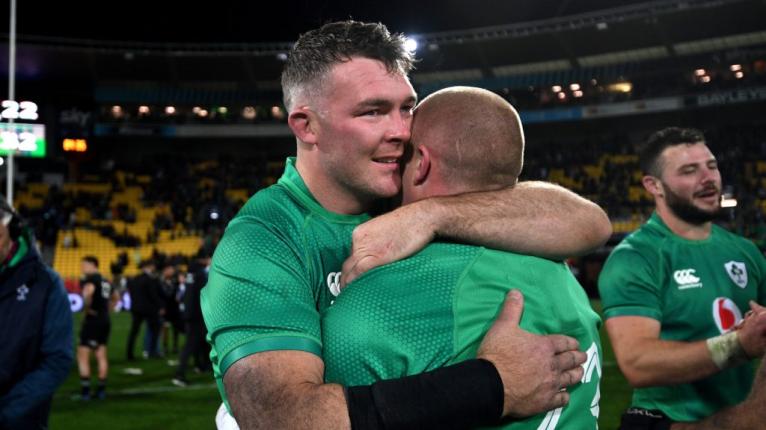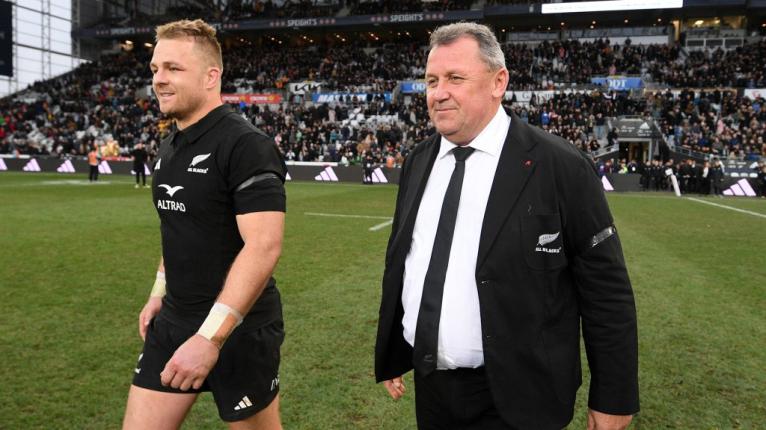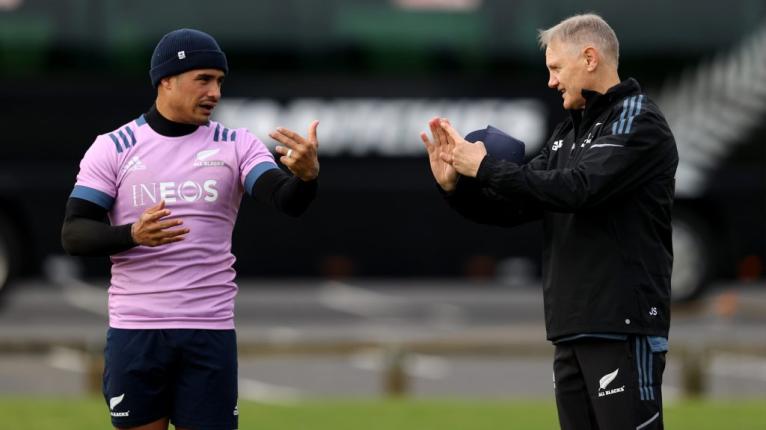The All Blacks have quietly morphed into Ireland, in what must be the ultimate example of imitation being the sincerest form of flattery.
The signs the All Blacks have looked long and hard at the Irish playbook and liked what they have seen, have been prevalent throughout the 2023 Test season.
There’s the way they have become a possession team, prepared to hold the ball through 20-plus phases to break a defence.
That newfound patience was best illustrated in the first Bledisloe Test of 2023, when they scored a try just before half-time, having rumbled through 21 phases in which 12 different players carried the ball until the space opened for Will Jordan to score in the corner.
This was classic Ireland – a team renowned for holding possession, which they did superbly last July when they beat the All Blacks in consecutive matches.
They were outstanding at retaining the ball in that series – patiently grinding the All Blacks down through their constant ability to have ball carriers on their feet, ready to go.
And this is where the All Blacks have again borrowed from Ireland. The big theme for their forwards this year has been the speed at which they can get back on their feet and into play.

That wasn’t a priority last year, but it is now, because the All Blacks saw how effective it made Ireland when their players were only ever on the deck for a split second.
“Keeping on our feet and getting people around the ball, that is something Joe [assistant coach and former longtime Ireland supremo Schmidt] is driving,” said veteran lock Brodie Retallick after the All Blacks had beaten South Africa in Auckland.
As Wallabies coach Eddie Jones noted after the first Bledisloe Test: “The big thing I see with them is their work rate is incredible.
“Tactically, they’ve probably simplified their game, but they were great off the ball, really first class, and that’s what we aspire to be.”
Then there is the issue of body height – again a lesson from the Ireland series. This year the All Blacks have placed a strong emphasis on being lower in the collision zones.
Ireland’s success in retaining possession and recycling it quickly lies in the ability of their ball carriers to win the collisions, and they do that because they hit contact in dynamic positions.
It’s a big improvement from where we were. We’re more mobile, we’re more skilled with ball in hand, better ball carriers. And there’s plenty of them.
And the importance of getting this right was highlighted by head coach Ian Foster when he gave his thoughts about why the All Blacks had struggled in the opening 20 minutes in each half against the Wallabies.
“I thought we coughed up the ball at the start of each half through our exits. Which is something we didn’t get quite right, mainly through the height of our carry and they were good enough to create problems.”
Body heights are just one part of the equation in the quest to emulate Ireland.
The All Blacks are also now benefitting from having eight players in their pack who are comfortable carrying the ball.
Last year when the All Blacks played Ireland, they had Nepo Laulala and Karl Tu’inakuafe at prop – neither of whom were renowned ball carriers.
Ireland had props who could take people on, make good progress with ball in hand and throw their weight around defensively.
The difference that made was tangible, as it meant there were times when the All Blacks were under siege from this green wall of attackers.

And while this problem was evident in 2022, it’s something the All Blacks have been trying to fix for five years.
Again, it was a problem which surfaced against Ireland, when the All Blacks lost in Dublin in 2018. The then head coach Steve Hansen saw his front-rowers were lacking the skills, mobility and influence of their Irish opposites, and he delivered a mandate to New Zealand’s Super Rugby coaches to try to do something to fix it.
The improvements he wanted were never quite delivered, a point he made the day after the All Blacks had unveiled the 33 players they were taking to France.
Hansen said he felt it was a stronger squad than the one he had picked in 2019, and specifically highlighted the higher calibre of prop going to France.
“I think back to the last World Cup I was concerned about our front-row, this front-row they are going to be able to pick this year is going to be outstanding,” said Hansen.
“It’s a big improvement from where we were. We’re more mobile, we’re more skilled with ball in hand, better ball carriers. And there’s plenty of them.”
So too are there strong traces of Ireland in the way the All Blacks have set up their midfield – both in personnel and strategy.
Last year they played David Havili at inside-centre – a handy ball player and decision-maker but not the same sort of crunching, direct threat as the 108kg Jordie Barrett, who has given the All Blacks another destructive threat in the midfield.
Mostly Barrett has been tasked with hammering the ball forward, in the most direct route available and even Rieko Ioane has spent most games doing much the same.
The wraparound has been Ireland’s signature move for the past decade and the All Blacks have incorporated it into their repertoire.
What’s noticeable is both are running straighter lines and gone is the old All Blacks habit of drifting across the field and making it easier for defences.
The tighter alignment has enabled the All Blacks to pull defences into the middle of the field and leave space out wide.
They have just had to learn to be patient about when to finally shift the ball to their wings.
The backline has also more regularly played a little deeper, which has meant that a la Johnny Sexton, Richie Mo’unga has been content to operate behind the forward pods, biding his time to pop up at first receiver and make an impact.
And, as was seen against Argentina, the All Blacks have lifted the number 10 wraparound directly from Ireland.
They scored a superb try when Jordie Barrett surprised the Pumas defence when he passed ‘out the back’ to Damian McKenzie who was looping behind.
He arced around and straightened into a huge hole before passing to Beauden Barrett who scored.
It was a try which showed how lethal McKenzie can be on the wraparound and we can expect to see Mo’unga used in the same way during the World Cup as he’s just as quick and agile.
The wraparound has been Ireland’s signature move for the past decade and the fact the All Blacks have incorporated it into their repertoire is irrefutable evidence they have scrutinised the world’s number one-ranked team and borrowed heavily from them.
And maybe that’s not such a surprise, for two reasons. Firstly, Ireland have troubled the All Blacks more than any other team in the last seven years.
Since the Irish won for the first time in Chicago 2016, the rivalry has been intense – with the All Blacks winning the return fixture in Dublin that year, before losing two years later in the Irish capital.
New Zealand exacted revenge when they hammered the men in green in the 2019 World Cup quarter-final but since then, it is two-one to Ireland.
Secondly, since August 2022, the All Blacks have had Schmidt working as their attack coach.

Schmidt, of course, having led Ireland between 2013 and 2019.
He was the man who modernised Ireland’s game plan and took them to another level, and his influence within the All Blacks has already been substantial.
“He was a game changer for me,” veteran halfback Aaron Smith said earlier this year.
“The way he saw the game, he had clips from training, he had clips from games way back, he really just gets rugby and he got my mindset.
“Joe wasn’t showing me clips of me running, he was just showing me opportunities, he was showing me what other nines had done and if it’s in your brain, that’s what happens, things just react.”
The great fascination now is thinking about what might happen should the All Blacks meet Ireland at this year’s World Cup.
Can the All Blacks out-Ireland, Ireland? Or will the real Ireland be too good for the aspiring version?
Either way, if they meet, it’s going to be a clash to remember.


What you on about?, NZ haven't morphed into Ireland. The arrogance and ignorance of the media. Ireland has not and will never have the record NZ have, and I do not see any otherside in the World kicking to wingers like NZ is doing, which means they have innovated those moves and that means they are not quietly "Morphed" into Ireland.
I hope NZ get Ireland and if they do, crush them, they are not and never will have NZs record. NZ have Morphed themselves into a good side with some changes. That does not mean, quietly Morphed into Ireland.
This is clearly click bait, as much as Ireland have bn incredible in the last 4 years, ABs attack has bn for 10 or more. So whose had the most impact on how team's attack today. Also let's rem the number of NZ coaches in European Union leagues. I think we are forgetting where Schmidt is from.
So the Boks can spend this weeks game figuring out how to beat both NZ and Ireland. Nice!
As an Irish fan I’m amused to see how some of you appear to be just a tad concerned by our guys 😉. Biggest issue for all the top sides is who’s going to be fit for knockout stages. Even the injuries shipped in recent warm up games will have altered plans. Back in the six nations game against England in March we lost three players in the first half alone. Let’s look forward to some great contests.
Oh Please... Ireland have been raiding NZ for years now to get to where they are... NZ have just put some lean years behind them.
Both have morphed into how the Crusaders play.
I think Gregor is a bit confused I think Ireland suddenly morphed into the way the All Blacks used to play, and abs have now moved back into that arena,
Gregor has a very short memory. It is not the ABs that discovered multiple phases, it is Foster.
Remember that ABs had 21 phases before Crotty scored the winning try (converted by Crudden) vs Ireland in Cardiff. In 2022, under the previous coaches the ABs were just unusually poor lacking imagination, clarity of purpose and clear selections...all that changed with Ryan and Schmidt but it does not make the ABs the same as Ireland (even though they do have three kiwi starters 😆 )
Schmidt hasn't had to scrutinise their playbook, he wrote most of it 🤣
Andy Farrell has moved Ireland on significantly in the last 4 yrs. But there is a lot of Schmidt's blue print still left.
NZ have more high quality players to choose from, but Ireland have had longer to build and cement a game plan.
I think Ireland would rather take a calculated game with NZ rather than the emotion of France in the QF.